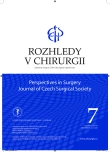Successfull therapy of grade III leak after thoracic oesophagectomy using endoscopic vacuum assisted closure therapy – a case study
Authors:
M. Stašek; R. Aujeský; R. Vrba; J. Chudáček; L. Bébarová; M. Gregořík; Dušan Klos
; Č. Neoral
Authors‘ workplace:
1. chirurgická klinika Lékařské fakulty Univerzity Palackého Fakultní nemocnice Olomouc
Published in:
Rozhl. Chir., 2018, roč. 97, č. 7, s. 349-353.
Category:
Case Report
Overview
Introduction:
Post-oesophagectomy leakage occurs in 1−30% of cases as a significant factor in postoperative morbidity and mortality, accounting for 40% of postoperative deaths. Endoscopic vacuum therapy (EVAC) is, besides stent therapy, clips and surgical therapy, a new endoscopic therapeutic modality.
Case report:
A 72-year-old polymorbid female patient with Siewert type II adenocarcinoma of the distal esophagus (T1b, N0, M0) was indicated for resection of the upper stomach and lower thoracic esophagus from laparotomy and thoracotomy with reconstruction using double-stapling anastomosis. On postoperative day 12, a 3rd degree leakage with propagation into the right pleural cavity was proven on CT. Endoscopy showed a defect affecting 30% of the circumference with a 7×3×3 cm cavity. Because of the leak morphology, EVAC was indicated. The therapy comprised 12 sessions with 3−4-day intervals for a total duration of 40 days with 5 extraluminal and 7 intraluminal applications and negative pressure of 100−125 mmHg. The condition was complicated by global respiratory failure due to severe pneumonia. Artificial ventilation was terminated on the 58th postoperative day. The patient was discharged to a rehabilitation facility on the 90th postoperative day. The follow-up 3 months after discharge confirms satisfactory performance results with full replenishment.
Conclusion:
The therapy of complications of intrathoracic anastomoses after oesophagectomy has shown a trend toward reduced invasiveness and wider implementation of endoscopic methods. In spite of its shortcomings, the use of EVAC is a safe and highly effective therapeutic option even for extensive anastomotic defects. The future use, indications as well as relation to other therapeutic options require further evaluation.
Key words:
endoscopic vacuum therapy − esophageal leakage – esophagectomy complications − intraoperative endoscopy
Sources
1. Dent B, Griffin SM, Jones R, et al. Management and outcomes of anastomotic leaks after oesophagectomy. Br J Surg 2016;103 : 1033−8.
2. Rizk NP, Bach PB, Schrag D, et al. The impact of complications on outcomes after resection for esophageal cancer and gastroeseophageal junction carcinoma. J Am Coll Surg 2004;198 : 42–50.
3. Schuchert MJ, Abbas G, Nason KS, et al. Impact of anastomotic leak on outcomes after transhiatal esophagectomy. Surgery 2010;148 : 831−8; discussion 838−40.
4. Nederlof N, de Jonge J, de Vringer T, et al. Does routine endoscopy or contrast swallow study after esophagectomy and gastric tube reconstruction change patient management? J Gastrointest Surg 2017;21 : 251−8.
5. Crestanello JA, Deschamps C, Cassivi SD, et al. Selective management of intrathoracic anastomotic leak after esophagectomy. J Thorac Cardiovasc Surg 2005;129 : 254−60.
6. Tuebergen D, Rijcken E, Mennigen R, et al. Treatment of thoracic esophageal anastomotic leaks and esophageal perforations with endoluminal stents: efficacy and current limitations. J Gastrointest Surg 2008;12 : 1168–76.
7. van Boeckel PG, Sijbring A, Vleggaar FP, et al. Systematic review: temporary stent placement for benign rupture or anastomotic leak of the oesophagus. Aliment Pharmacol Ther 2011;33 : 1292–1301.
8. Haito-Chavez Y, Law JK, Kratt T, et al. International multicenter experience with an over-the-scope clipping device for endoscopic management of GI defects (with video). Gastrointest Endosc 2014;80 : 610−22.
9. Mennigen R, Senninger N, Laukoetter MG. Novel treatment options for perforations of the upper gastrointestinal tract: Endoscopic vacuum therapy and over-the scope clips. World J Gastroenterol 2014;20 : 7767−76.
10. Wedemeyer J, Schneider A, Manns MP, et al. Endoscopic vacuum-assisted closure of upper intestinal anastomotic leaks. Gastrointest Endosc 2008;67 : 708–11.
11. Kuehn F, Loske G, Schiffmann L, et al. Endoscopic vacuum therapy for various defects of the upper gastrointestinal tract. Surg Endosc 2017;31 : 3449–58.
12. Laukoetter MG, Mennigen R, Neumann PA, et al. Successful closure of defects in the upper gastrointestinal tract by endoscopic vacuum therapy (EVT): a prospective cohort study. Surg Endosc 2017;31 : 2687−96.
13. Schniewind B, Schafmayer C, Voehrs G, et al. Endoscopic endoluminal vacuum therapy is superior to other regimens in managing anastomotic leakage after esophagectomy: a comparative retrospective study. Surg Endosc 2013;27 : 3883–90.
14. Brangewitz M, Voigtländer T, Helfritz FA, et al. Endoscopic closure of esophageal intrathoracic leaks: stent versus endoscopic vacuum-assisted closure, a retrospective analysis. Endoscopy 2013;45 : 433–8.
15. Mennigen R, Harting C, Lindner K, et al. Comparison of endoscopic vacuum therapy versus stent for anastomotic leak after esophagectomy. J Gastrointest Surg 2015;19 : 1229–35.
Labels
Surgery Orthopaedics Trauma surgeryArticle was published in
Perspectives in Surgery

2018 Issue 7
- Metamizole vs. Tramadol in Postoperative Analgesia
- Current Insights into the Antispasmodic and Analgesic Effects of Metamizole on the Gastrointestinal Tract
- Spasmolytic Effect of Metamizole
- Metamizole at a Glance and in Practice – Effective Non-Opioid Analgesic for All Ages
Most read in this issue
- The use of retrosternally placed colon in esophageal replacement
- Prophylactic ligation of the thoracic duct in the prevention of chylothorax after esophagectomy
- Esophageal cancer − results of surgical treatment at the Department of Surgery I. at the University Hospital Olomouc
- Results of minimally invasive esophagectomy for esophageal cancer performed after ischemic gastric conditioning
